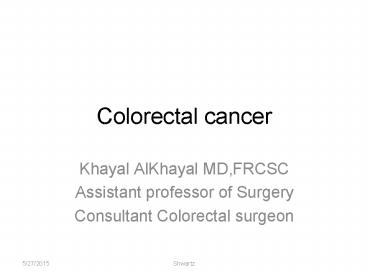Colorectal cancer - PowerPoint PPT Presentation
1 / 40
Title:
Colorectal cancer
Description:
... lymph nodes Open vs laparoscopic approach Right hemi Colectomy Left hemicolectomy Abdominoperineal resection Subtotal Colectomy Anterior resection Low ... – PowerPoint PPT presentation
Number of Views:158
Avg rating:3.0/5.0
Title: Colorectal cancer
1
Colorectal cancer
- Khayal AlKhayal MD,FRCSC
- Assistant professor of Surgery
- Consultant Colorectal surgeon
5/27/2015
Shwartz
2
Outline
- Definitions
- Polyps
- Basics of colorectal cancer
- Surgery
- Staging
3
Perspective
4
Definitions
- Colon large bowel large intestine
- Rectum - terminal portion of the colon
- Polyp - benign growth not invasive
- Adenoma - type of polyp
- Cancer - malignant growth invasive
- Stage - where the cancer is growing
- Primary - the original tumour, where it started
- Metastases - where the tumour has spread to
5
Cancer
- A cancer cell
- is immortal ( lives forever)
- multiplies uncontrollably
- can live on its own without neighbors
- can live in other parts of the body
6
Colon and Rectum
7
Colorectal Cancer
- Most cancers are acquired some are inherited
- Almost all cancers begin as a benign polyp or
adenoma - Only a tiny percentage of adenomas become cancers
8
What is a polyp?
9
Polyp - Cancer Sequence
- The process from benign polyp to cancer takes
from 7 - 10 years - The transformation into cancer is based on
- the type of polyp
- Size of polyp
- Multiple polyps greater risk of cancer
10
5/27/2015
Shwartz
11
(No Transcript)
12
The Effect of Age on the Incidence of Colorectal
Cancer and Colorectal Polyps
13
Removing polyps prevents cancer
- Colonoscopy
14
Colorectal Carcinoma
- Classification
- Adenocarcinoma 95
- Carcinoid
- Lymphoma
- Sarcoma
- Squamous cell carcinoma
15
Epidemiology
- 3th most common malignancy worldwide.
- 1st most common in Saudi males.
- second to lung cancer as a cause of cancer death
- 21,500 new cases, 8900 will die (2008)
- risk of CRC women 1/16 , men 1/14
- peek incidence in 7th decade but it can occur at
any age
16
Etiology of Colorectal Cancer
17
Risk Factors
- Genetics, Family history
- Personal history
- One first degree family member doubles risk
- Hereditary colorectal cancer syndomes
- Polyps
- Inflammatory bowel disease
- Other
- Diet, nutrients, smoking, ETOH
18
Colorectal Cancer Risk Based on Family History
- General population 6
- One 1st degree CRC 2-3X (12-18)
- Two 1st degree CRC 3-4X
- One 1st degree CRC lt 50 y 3-4
- One 2nd or 3rd CRC 1.5X
- 2 2nd degree CRC 2-3X
- 1 first degree with polyp 2X
19
Clinical presentation
- Bleeding - gross, occult, anemia (37)
- Change in bowel habit pain, diarrhea,
constipation, alternating pattern - Obstruction more common with left sided lesions
most common cause of bowel obstruction in the
elderly - Vague abdominal pains
- Change in caliber of the stools
- Weight loss
- Abdominal mass
- Asymptomatic
20
Investigations
- General
- Complete history and physical (DRE)
- Endoscopic (identify primary, synchronous
lesions) - Flexible sigmoidoscopy
- Colonoscopy
- Staging
- Endorectal ultrasound (rectal cancer)
- Chest x-ray (metastases)
- Liver ultrasound (metastases)
- Abdominal CT scan (metastases)
- Bloodwork
- CBC electrolytes, CEA (tumour marker)
21
5/27/2015
Shwartz
22
Surgical therapy
- Surgery is the most important variable in the
treatment of colorectal cancer - Radiation and chemotherapy alone cannot cure any
stage of colorectal cancer - The site of tumour dictates the basic procedure
23
(No Transcript)
24
Principles of Surgery
- Examine the entire abdomen
- Remove the appropriate segment of the colon with
adequate margins - Remove the corresponding lymph nodes
- Open vs laparoscopic approach
25
Right hemi Colectomy
Left hemicolectomy
Abdominoperineal resection
26
Anterior resection
Subtotal Colectomy
Low Anterior resection
27
(No Transcript)
28
(No Transcript)
29
(No Transcript)
30
5/27/2015
Shwartz
31
(No Transcript)
32
Follow up
- Office visit every 3 months for two years then
every 6 months for 3 years - Regular blood work (CEA)
- Colonoscopy at year 1 and 4 and every 5 years
- CT scan yearly
33
Pathology of Colorectal Cancer
- Macroscopic
- Microscopic (differentiation)
- Well
- Moderately
- Poorly
- Lymph node involvement
34
Staging ( Where is it Growing?)
- 1. How far into the wall has it grown? T stage
- Tis invasion of mucosa only
- T1 Invasion of submucosa
- T2 Invasion of muscularis propria
- T3 Full thickness/perirectal fat
- T4 Invasion into adjacent organs
35
Staging ( Where is it Growing?)
- 2. Is it growing in other places? N stage, M
stage - N1 1-3 lymph nodes
- N2 - gt4 lymph nodes
- N3 distant lymph nodes
- M1 Distant organ ( liver, lung)
36
TNM Staging
- Stage 0 Tis tumors
- Stage 1 T1 and T2 tumors
- Stage 2 T3 and T4 tumors
- Stage 3 Any lymph node involvement
- Stage 4 Distant metastases
37
Who Gets Additional Treatment?
- COLON
- All stage 3 patients (positive nodes) -
chemotherapy - ?High risk stage 2 patients
- RECTUM
- All stage 2 and stage 3 patients should get
radiation and chemo
38
Survival and TNM Stage
- STAGE 5-Year Survival
- 1 90
- 2 80
- 3 27-69
- 4 8
- for T3N0 tumors
- depends on of nodes involved
39
Summary
- Common Cancer
- Can be prevented through screening and resection
of polyps - Surgery is the primary treatment
- Slow but steady improvement in survival
40
(No Transcript)

